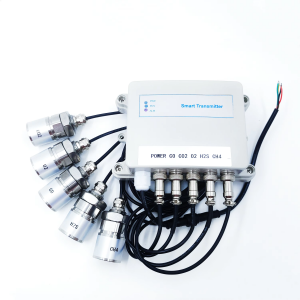په صنعت کې د هوا د کیفیت څارنه
د اندونیزیا په ګڼه ګوڼه صنعتي سکتورونو کې، د هوا ککړتیا یوه مهمه اندیښنه ده. فابریکې او تولیدي فابریکې ډیری وختونه مختلف ګازونه خارجوي چې کولی شي چاپیریال او عامه روغتیا دواړو ته زیان ورسوي. د 5-in-1 سینسر د اکسیجن (O2)، کاربن مونو اکسایډ (CO)، کاربن ډای اکسایډ (CO2)، میتان (CH4)، او هایدروجن سلفایډ (H2S) غلظت اندازه کوي. د دې ګازونو په دوامداره توګه څارنه کولو سره، صنعتونه کولی شي:
-
د چاپیریالي مقرراتو سره سم اطاعت ډاډمن کړئ: د ګازو د اخراج په اړه د سختو مقرراتو سره، صنعتونه باید د جریمې څخه د مخنیوي لپاره لارښوونو ته غاړه کیږدي. د 5-in-1 سینسر ریښتیني وخت معلومات چمتو کوي چې کولی شي شرکتونو سره د اطاعت کولو کې مرسته وکړي.
-
د کار ځای خوندیتوب ښه کړئ: د CO او H2S د کچې څارنه د کارګرانو د ساتنې لپاره خورا مهمه ده په هغه چاپیریال کې چیرې چې دا ګازونه راټولیږي. د زیان رسونکي ګاز غلظت ژر کشف کولی شي د پیښو مخه ونیسي او د کارمندانو روغتیا خوندي کړي.
-
** د پروسو اصلاح کول**: د سینسرونو څخه راټول شوي معلومات صنعتونو ته اجازه ورکوي چې خپل اخراج تحلیل کړي او د ضایعاتو کمولو او موثریت ښه کولو لپاره پروسې تنظیم کړي، چې د لګښت سپمولو او د کاربن فوټ پرینټ کمولو لامل کیږي.
په کرنه باندې اغیزه
کرنه د اندونیزیا د اقتصاد یو بنسټ دی، چې د هغې په ناخالص کورني تولید کې د پام وړ ونډه لري او د ملیونونو خلکو لپاره د ژوند زمینه برابروي. په هرصورت، د کرنې طریقې کولی شي د هوا د کیفیت ستونزې هم رامینځته کړي، په عمده توګه د څارویو او وریجو د کروندو څخه د میتان اخراج له لارې. د 5-in-1 سینسر کولی شي د کرنې سکتور سره مرسته وکړي:
-
د دوامداره کړنو ترویج: بزګران کولی شي د سینسر معلوماتو څخه کار واخلي ترڅو د خپلو عملیاتو څخه د اخراج څارنه وکړي، چې د کرنې ډیر دوامداره طریقې رامینځته کوي. د میتان کچې په پوهیدو سره، بزګران کولی شي د شنو خونو ګازونو اخراج کمولو لپاره د سرې مدیریت غوره طریقې پلي کړي.
-
د فصلونو مدیریت ښه کول: د هوا کیفیت په مستقیم ډول د نباتاتو روغتیا اغیزه کوي. د CO2 لوړه کچه کولی شي د فصل وده اغیزمنه کړي، او د 5-in-1 سینسر په کارولو سره، بزګران کولی شي د خپلو فصلونو لپاره غوره شرایط ډاډمن کړي. دا څارنه کولی شي لوړ حاصلات او غوره کیفیت لرونکي محصولات رامینځته کړي.
-
د چاپیریال ساتنه: د زیان رسوونکو ګازونو د اخراج په پیژندلو او مدیریت کولو سره، کرنه کولی شي د چاپیریال اغیزې د پام وړ کمې کړي، د اقلیم د بدلون سره د مبارزې او ایکولوژیکي توازن په وده کې مرسته وکړي.
پایله
د اندونیزیا د صنعتي او کرنیزو سکتورونو لپاره د 5-in-1 د هوا کیفیت سینسر کارول چې O2، CO، CO2، CH4، او H2S اندازه کوي خورا مهم دي. دا سینسرونه مهم معلومات چمتو کوي چې کولی شي د خوندي کاري چاپیریال، ډیر دوامداره کرهنیزو کړنو، او د هوا کیفیت کې عمومي پرمختګونو لامل شي. لکه څنګه چې اندونیزیا وده او پراختیا ته دوام ورکوي، د عامه روغتیا او چاپیریال ساتنې لپاره به د پرمختللي هوا کیفیت څارنې ټیکنالوژۍ کې پانګونه اړینه وي.
د ګاز سینسر په اړه د نورو معلوماتو لپاره، مهرباني وکړئ د هونډ ټیکنالوژۍ شرکت، لمیټډ سره اړیکه ونیسئ.
برېښنالیک:info@hondetech.com
د شرکت ویب پاڼه:www.hondetechco.com
ټیلیفون: +۸۶-۱۵۲۱۰۵۴۸۵۸۲
د پوسټ وخت: اپریل-۱۷-۲۰۲۵


